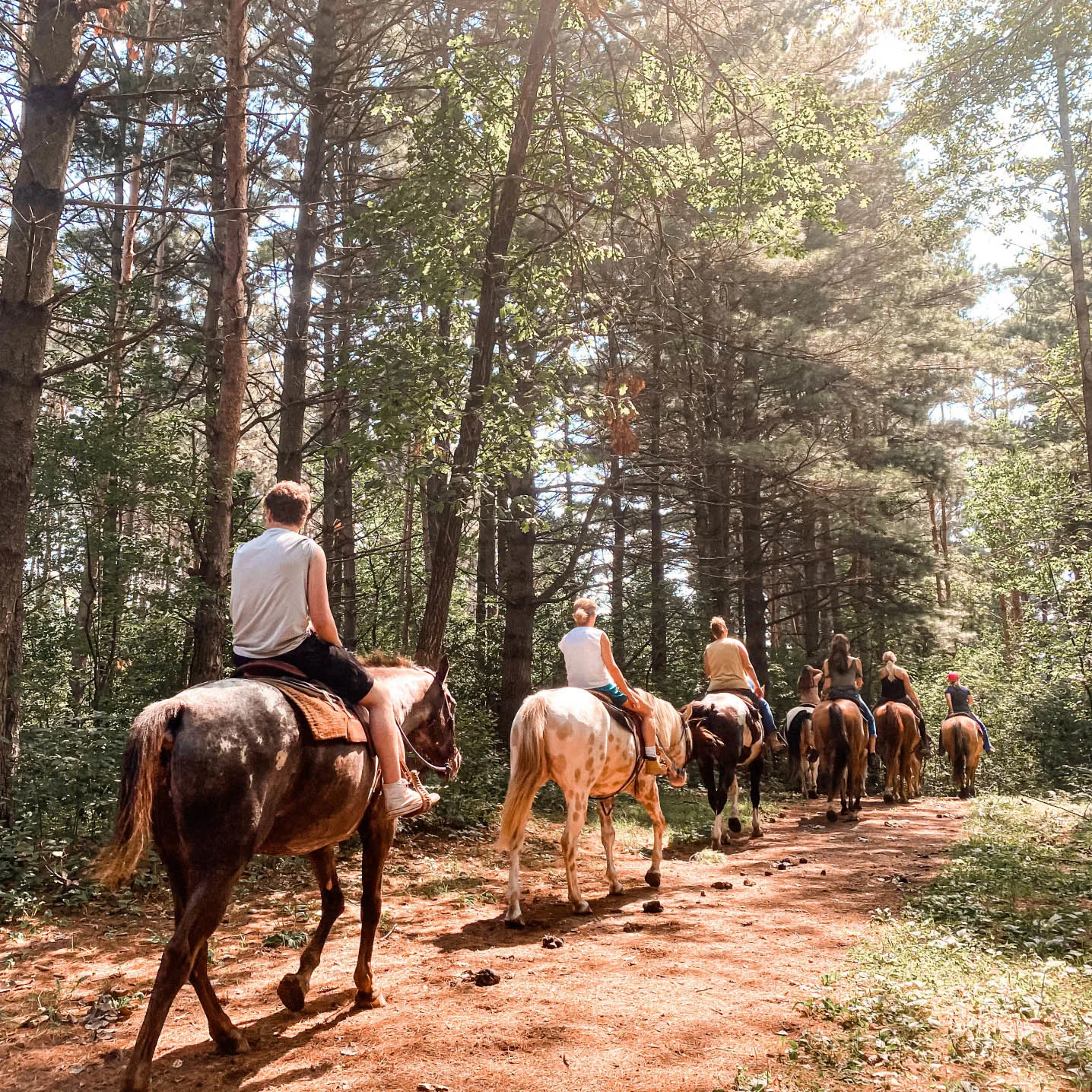Riding Horses can be the most exciting part of a mountain vacation, tropical island retreat, or even African safari! To make the most of your experience riding horses on vacation, though, you’ll need to be armed with information about what to expect, how to prepare, what to pack, and how to avoid soreness the next day. (For the sake of length, we’ve relegated that last point to its own article)
One of my favorite things about going on vacation is finding different activities to try while exploring a new area. Trail riding is at the top of my favorite activities to do while on vacation. Being able to enjoy nature from the back of a horse is not something everyone gets to experience. Luckily, there are lots of riding facilities around the U.S. that focus on taking tourists on guided trail rides so they can see the area they are visiting from a different perspective. If you have never ridden a horse on vacation before, you are probably wondering what to expect.

What to Pack for Horseback Riding Trail Rides on Vacation
- Sunscreen – While trail riding often means riding in areas with lots of trees and shade, it is also possible you will ride through open clearings, or to vistas to take in a view. In these areas you are likely to encounter a lot of direct sunlight, so it is best to be prepared for it and apply some sunscreen at the start of the ride.
- Bug spray – Horses in general tend to attract a lot of flies, but when trail riding you will probably come across other insects as well. There also may be small streams to cross on the trail, or shallow ponds, so mosquitos are always a possibility as well.
- Water – Staying hydrated is always important, especially if it is hot out. Ask your guide before the ride starts if there is a way to safely bring your water bottle along.
What to Wear to Ride Horses on Vacation
- Long pants – These are ideal for horseback riding. Most saddles are made of leather, and they can be very rough on your skin as you are riding. For this reason, shorts are usually not recommended.
- A light jacket or sweatshirt – Either of these are good to have when trail riding in the mountains. Even in the summer, heavily wooded areas can get chilly with a lot of shade.
The Best Shoes to Wear Trail Riding:
- 👢Cowboy Boots – A pair of boots with a low heel are preferred when riding horses. The heel of the boot will prevent your foot from sliding through the stirrup and getting stuck.
- 👞Chelsea Boots – a study pair of Chelsea boots – like Blundstones – are perfect for riding. Chelsea boots are a style that originated around horses.
- 🥾Work Boots – Work boots often have a tough toe cap and a slight heel lift- making them chunky but safe for trail riding horses.
- 👟 Tennis Shoes – Tennis shoes are a last resort and might not be allowed. Some riding facilities may allow you to wear close-toed shoes that aren’t boots, but it is best to check ahead of time.
Some beach trail riding facilities and horse rental barns might have boots available to borrow for the ride. Use at your own discretion!
Never wear open-toed shoes around horses. They are large animals, and if they step on your foot without some sort of protection for your toes, it can cause severe damage. Sandals are also not safe footwear for riding a horse, as it is very easy for the sole of the shoe to slide through the stirrup and get your foot caught.
For more tips on dressing for horseback riding and example outfits for trail rides, see our ultimate guide to what to wear horseback riding.
Questions to Ask Before Booking Trail Riding Vacations
- What is the ratio of riders to guides? – If the group is too large and there are only a couple of guides, they won’t be able to keep a close eye on everyone at once. If you encounter a problem on the trail, it might take them a while to notice or get to you to help. Smaller groups are safer, and they allow the ride to keep moving with fewer stops for adjustments.
- Do they provide helmets for all riders? – The number one safety tool used by equestrians is a helmet. There is always a risk of injury when horseback riding. Even the calmest, most well-trained horse has the potential to spook, or they could trip on the trail and cause their rider to fall. Helmets will protect you from serious head injuries. They may not seem fashionable, or comfortable, but safety is more important than appearance. If a facility does not provide helmets for their guests, then they are not taking safety seriously and should be avoided.
- What is the age requirement for children? – All vacation riding facilities should have a minimum age requirement to go on a trail ride, but what that age is will vary from place to place. Some places might have a lead line option, which would allow younger children to ride with a guide walking alongside them. If this is not an option, then expect a minimum age of at least 5-7. The child will need to be old enough to sit up on the horse by themselves, steer, and not be afraid. This should be listed on the facility’s website, but if it isn’t, then call before booking.
How to Interact With the Horses Safely
Horses used for vacation trail rides are usually very calm and easy going, and they are very used to being around new riders. It is still good to know how to safely interact with them. When approaching a horse, make sure to talk to them in a normal, yet calm, speaking voice. Let them sniff your hand if they want to, and be sure to approach them from the side. Horses have a blind spot directly in front of them, and directly behind them, so do not approach a horse from these directions. Loud, sudden noises will spook a horse, so make sure not to run up to them or scream and yell around them.
What to Expect Before You Ride
Before you begin your trail riding experience, the guides will want to know how much, if any, horse riding experience you have. This is so they can pair up riders with horses that will fit with their experience level. They do not want to pair a beginner rider with an inexperienced horse. They will tell you the horse’s name, a little about their personality, which horses in the group they like, and which ones they prefer to stay away from. The guides will also give you a quick lesson on how to ask your horse to walk, stop, and turn.
What to Expect on the Trail
Typically, when trail riding, everyone will ride in a single file line. Depending on where you are vacationing, you may encounter peaceful, wooded trails; breathtaking views; wildlife; and water crossings to ride through. While on narrow, rocky, or wooded trails, expect to stay at a walk for a lot of the time. If the trail opens up into a clearing, the guides might allow riders to go a little faster for a stretch, such as at a trot or slow canter. Each riding facility has their own rules and plans, so this is not a guarantee. The guides will do what they feel is safest for the group of riders they have at the time.
If you’d like to read up on safety, read our tips for staying safe while trail riding.

What to Expect After the Ride
People often have the expectation that riding horses is easy, and the horse does all the work. The reality is that horseback riding is a sport and a workout, even when just walking!
If you have not ridden before, or do not ride regularly, then expect muscle soreness following your trail ride. It is probably best not to schedule any strenuous activities for the next day while your body recovers. Try some strategies for reducing post-ride soreness.
Final Thoughts on Riding Horses on Vacation
When booking your trail ride, don’t forget to ask any and all questions to make sure it is the right fit for your group. Listening to your guide(s) on the ride will help ensure you have the best possible experience. Enjoy the opportunity to explore nature from a different perspective. Trail riding on vacation is a great way to make your trip truly unforgettable!
